Documents: Go to download!
- Owner's manual - (English, French)
- PARTS AND FEATURES
- USING YOUR REFRIGERATOR
- WATER FILTER
- CARE AND CLEANING
- TROUBLESHOOTING GUIDE
Table of contents
Owner Manual Bottom Freezer Refrigerator
PARTS AND FEATURES

Use this page to become more familiar with the parts and features of your refrigerator.
NOTE: This guide covers several different models. The refrigerator you have purchased may have some or all of the items listed below. The locations of the features shown below may not match your model.

A Refrigerator Light
B Water Filter (Inside)
C Adjustable Door Bins
D Fixed Door Bins
E Refrigerator Shelves
F Ice Compartment
(Icemaker and Ice Bin)
G Humidity Controlled Crisper
H Temperature Controlled Pantry Drawer
I Extra Ice Bin
J Pullout Drawer
K Durabase
L Durabase Divider
M Dairy Bin
N Water Tank Cover
O Articulating Mullion
P Air Filter
Q Kenmore ConnectTM Speaker
USING YOUR REFRIGERATOR
SETTING THE CONTROLS
The refrigerator control functions as the thermostat for the entire appliance (refrigerator and freezer sections). The colder the setting, the longer the compressor will run to keep the temperature colder. The freezer control adjusts the cold air flow from the freezer to the refrigerator. Setting the freezer control to a lower temperature keeps more cold air in the freezer compartment to make it colder.
AIRFLOW
Cold air circulates from the freezer to the fresh food section and back again through air vents in the wall dividing the two sections. Be sure not to block vents while packing your refrigerator. Doing so will restrict airflow and may cause the refrigerator temperature to become too warm or cause interior moisture buildup. (See air flow diagram below.)
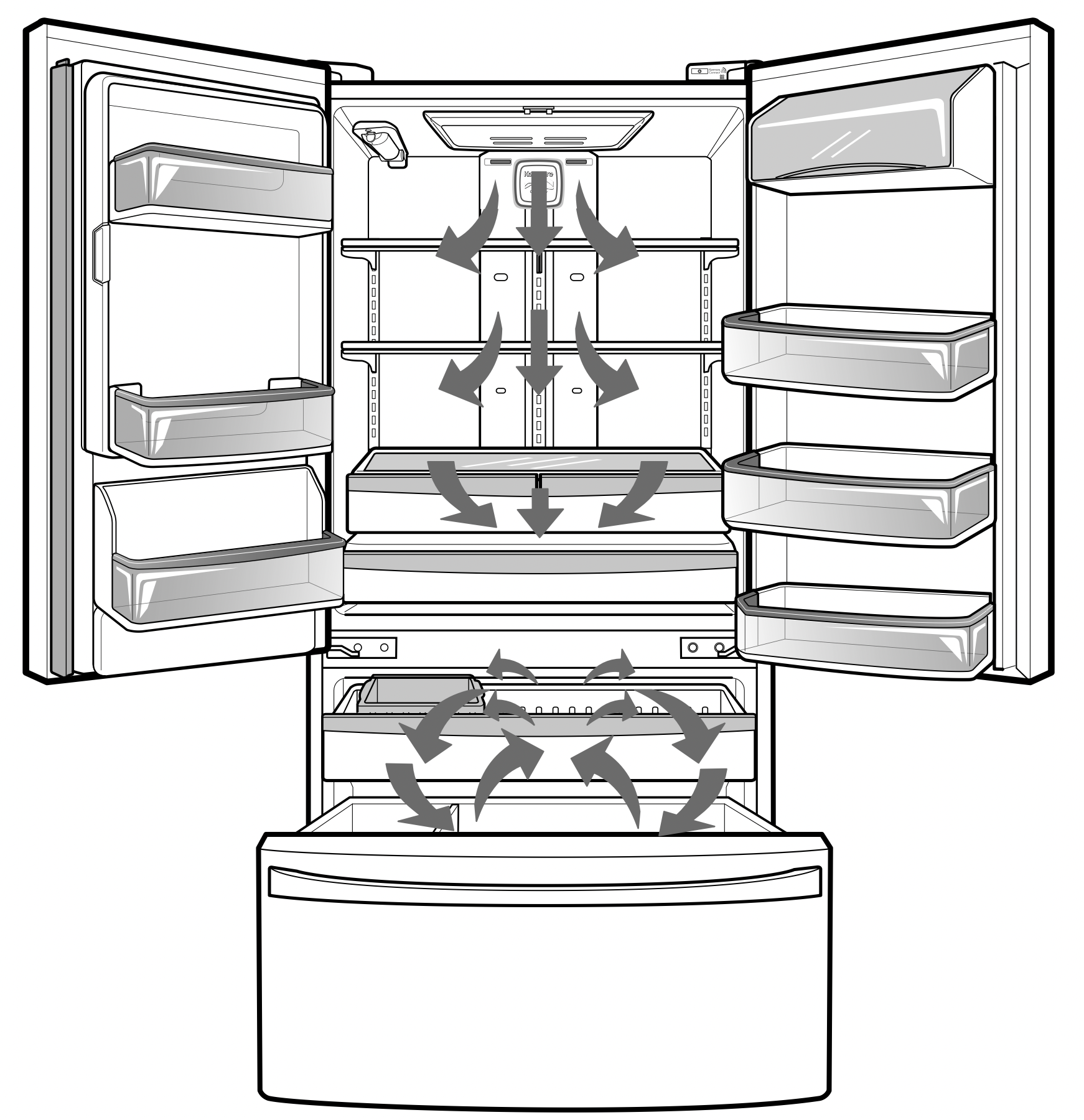
Temperature

- The Refrigerator Temp. Control ranges from 33°F to 46°F (0°C to 8°C). Press the Refrigerator Temp. button to cycle through the available temperature settings one increment at a time.
- The Freezer Temp. Control range is from -6°F to 8°F (-21°C to -13°C). Press the Freezer Temp. button to cycle through the available temperature settings one increment at a time.
NOTE: When changing control settings, wait 24 hours before making additional adjustments. The controls are set correctly when milk or juice is as cold as you would like and when ice cream is firm. If the temperature in either compartment is too cold or too warm, change the setting one increment at a time. Wait 24 hours for the change to stabilize before adjusting again.
Dispenser
- When you press the Water button, the water icon will illuminate.

- When you press the Ice Select button, either the cubed or crushed ice icon will illuminate.

- Some dripping may occur after dispensing. Hold your cup beneath the dispenser for a few seconds after dispensing to catch all of the drops.
CAUTION: The control display is operated by touch. Excessive moisture on the display may cause a malfunction. Please keep the display clean and dry.
WARNING: The dispenser will not work if any door is left open or if the control lock is engaged.
Ultra Ice 
- When you touch the Ultra Ice button, the graphic will illuminate in the display and will continue for 24 hours. The function will automatically shut off after 24 hours.
- You can stop this function manually by touching the button one more time.
- This function increases both ice making and freezing capabilities.
Water Filter Reset 
When the water filter indicator turns on, you have to change the water filter. After changing the water filter, press and hold the Ultra Ice (Water Filter Reset) button for three seconds to turn the indicator light off. You need to change the water filter approximately every six months.
Blue Ambient Mood Light 
This light has two settings: On and Off. If the light is set to the On mode, the Blue Ambient Mood Light will turn on.
Air Filter 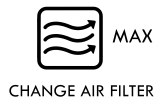
The Air Filter helps remove odors from the refrigerator. The Air Filter has two settings, Auto ad MAX. In Auto mode, the Air Filter will cycle on and off in increments of ten minutes on and 110 minutes off. If set to the MAX mode, the Air Filter will stay on continuously for four hours, cycling on and off in increments of ten minutes on and five minutes off. After four hours, the Air Filter will switch to Auto mode.
- Auto mode is the default mode.
- Press the Air Filter button once for MAX mode.
Air Filter Reset 
When the CHANGE AIR FILTER icon turns on, the air filter needs to be replaced. After replacing the air filter, press and hold the Air Filter button for three seconds to turn the icon light off. It is recommended to change the air filter approximately every six months.
Articulating Mullion
This feature is a metal strip attached to the left door that articulates (rotates) 90 degrees as the door is closed, forming a mullion (base) for the left and right door gaskets to seal against.
CAUTION: To reduce the risk of scratching the door or breaking the door mullion, make sure that the refrigerator door mullion is always folded in.

Door Alarm 
- When power is connected to the refrigerator, the door alarm is initially set to ON. When you press the Door Alarm button, the display will change to OFF and the Door Alarm function will deactivate.
- When either the refrigerator or the freezer door is left open for more than 60 seconds, the alarm tone will sound to let you know that the door is open.
- When you close the door, the door alarm will stop.
Control Lock 
- When power is initially connected to the refrigerator, the Lock function is off.
- If you want to activate the Lock function to lock other buttons, press and hold the Door Alarm button for three seconds or more. The Control Lock icon will display and the Lock function is now enabled.
- When the Lock function is activated, no other buttons will work. The dispenser pad is also deactivated.
- To disable the Lock function, press and hold the Door Alarm button for approximately three seconds.
Temperature Mode Switch Function (°F <->°C)
If you want to convert °F to °C or vice versa, press and hold the Freezer Temp. and Refrigerator Temp. buttons at the same time for approximately five seconds.
Display Off Mode
- When the refrigerator is in the Display Off Mode, the display will remain off until a door is opened or a button is pressed. Once on, the display will remain on for 20 seconds.
- To deactivate the Display Off Mode, press the Freezer Temp. and Ultra Ice buttons at the same time and hold them for five seconds until the tone sounds (in some models).

CAUTION
Demo Mode (For Store Use Only)
The Demo Mode disables all cooling in the refrigerator and freezer sections to conserve energy while on display in a retail store. When activated, OFF will display on the control panel.

To deactivate: With either refrigerator door opened, press and hold the Refrigerator Temp. and Ultra Ice buttons at the same time for five seconds. The control panel will beep and the temperature settings will display to confirm that Demo Mode is deactivated. Use the same procedure to activate the Demo Mode.
IN-DOOR ICE BIN
CAUTION
Keep hands and tools out of the ice compartment door and dispenser chute. Failure to do so may result in damage or personal injury.
The icemaker will stop producing ice when the in-door ice bin is full. If you need more ice, empty the ice bin into the extra ice bin in the freezer compartment. During use, the ice can become uneven causing the icemaker to misread the amount of ice cubes and stop producing ice. Shaking the ice bin to level the ice within it can reduce this problem.
NOTE: Storing cans or other items in the ice bin will damage the icemaker.
Keep the ice compartment door closed tightly. If the ice compartment door is not closed tightly, the cold air in the ice bin will freeze food in the refrigerator compartment. This could also cause the icemaker to stop producing ice.
NOTE: If the ON/OFF switch on the icemaker is set to OFF for an extended period of time, the ice compartment will gradually warm up to the temperature of the refrigerator compartment. To prevent ice cubes from melting and leaking from the dispenser, ALWAYS empty the ice bin when the icemaker is set to OFF for more than a few hours.
CAUTION: When handling the ice bin, keep hands away from the icemaker tray area to avoid personal injury.

- Pull or push the door handle to open or close the ice compartment.

- To remove the in-door ice bin, grip the front handle, slightly lift the lower part, and slowly pull out the bin as shown.
See other models: 79049 79043 70214 70213 75049

- To reinstall the in-door ice bin, slightly slant the bin during replacement to avoid contact with the icemaker.

- Avoid touching the ice-detecting sensor when replacing the ice bin. See the label on the ice compartment door for details.
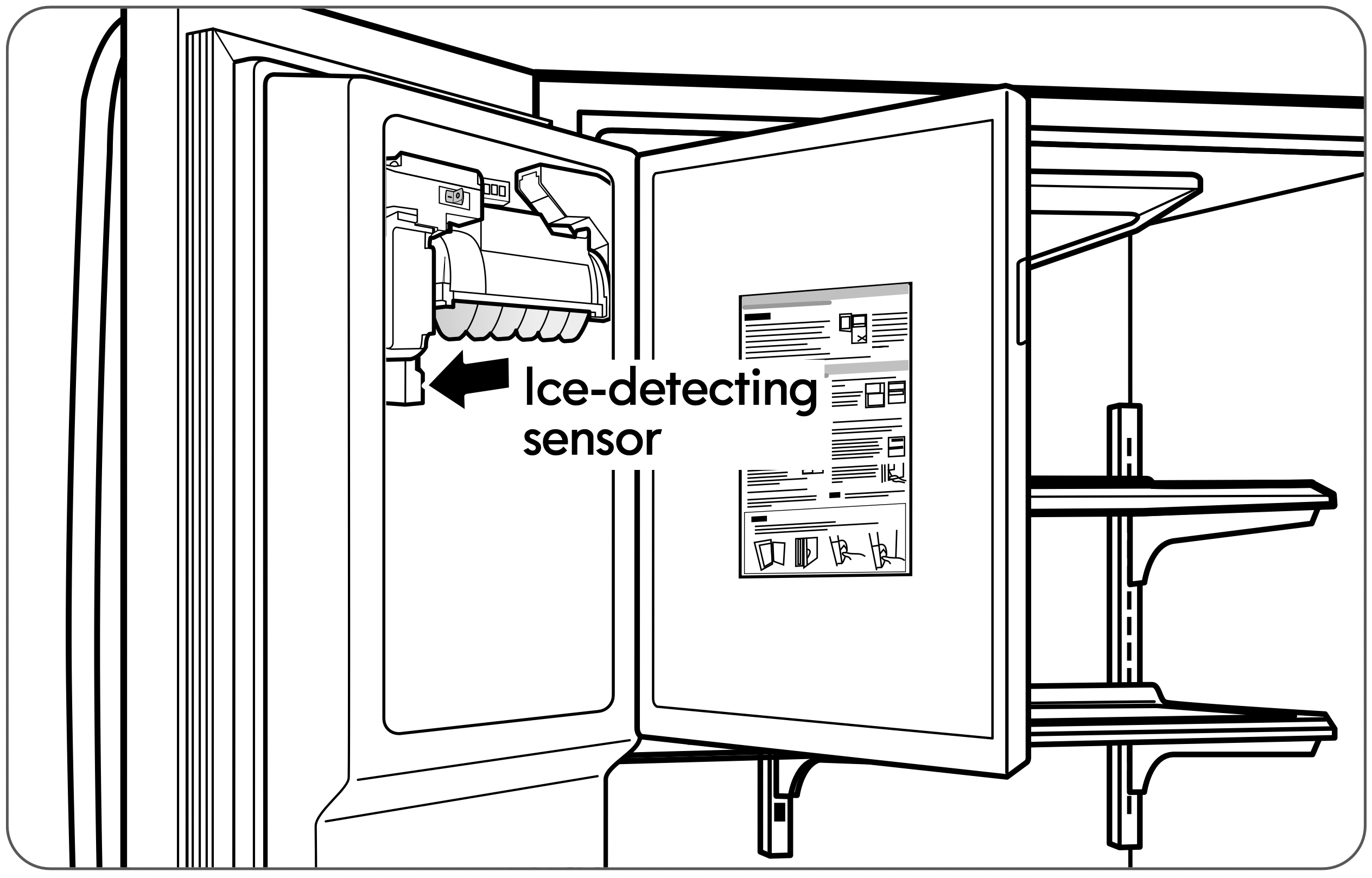
AUTOMATIC ICEMAKER
Ice is made in the automatic icemaker and sent to the dispenser. The icemaker will produce 10 cubes per cycleapproximately 100 cubes in a 24-hour period, depending on freezer compartment temperature, room temperature, number of door openings and other operating conditions.
- It takes about 12 to 24 hours for a newly installed refrigerator to begin making ice. Wait 72 hours for full ice production to occur.
- Ice making stops when the in-door ice bin is full. When full, the in-door ice bin holds approximately 6 to 8 (1216 oz) glasses of ice.
- To turn off the automatic icemaker, set the icemaker switch to OFF (O). To turn on the automatic icemaker, set the switch to ON (I).
- The water pressure must be between 20 and 120 psi on models without a water filter and between 40 and 120 psi on models with a water filter to produce the normal amount and size of ice cubes.
- Foreign substances or frost on the ice-detecting sensor can interrupt ice production. Make sure the sensor area is clean at all times for proper operation.
WARNING - Personal Injury Hazard: DO NOT place fingers or hands on the automatic ice making mechanism while the refrigerator is plugged in.

CAUTION
- The first ice and water dispensed may include particles or odor from the water supply line or the water tank.
- Throw away the first few batches of ice (about 24 cubes). This is also necessary if the refrigerator has not been used for a long time.
- Never store beverage cans or other items in the ice bin for the purpose of rapid cooling. Doing so may damage the icemaker or the containers may burst.
- If discolored ice is dispensed, check the water filter and water supply. If the problem continues, contact a Sears or other qualified service center. Do not use the ice or water until the problem is corrected.
- Keep children away from the dispenser. Children may play with or damage the controls.
- The ice passage may become blocked with frost if only crushed ice is used. Remove the frost that accumulates by removing the ice bin and clearing the passage with a rubber spatula. Dispensing cubed ice can also help prevent frost buildup.
- Never use thin crystal glass or crockery to collect ice.
Such containers may chip or break resulting in glass fragments in the ice. - Dispense ice into a glass before filling it with water or other beverages. Splashing may occur if ice is dispensed into a glass that already contains liquid.
- Never use a glass that is exceptionally narrow or deep. Ice may jam in the ice passage and refrigerator performance may be affected.
- Keep the glass at a proper distance from the ice outlet.
A glass held too close to the outlet may prevent ice from dispensing. - To avoid personal injury, keep hands out of the ice door and passage.
- Never remove the dispenser cover.
- If ice or water dispenses unexpectedly, turn off the water supply and contact Sears Home Service at 1-800-4-MY HOME® .
WHEN YOU SHOULD SET THE ICEMAKER POWER SWITCH TO OFF (O)
- When the water supply will be shut off for several hours.
- When the ice bin is removed for more than one or two minutes.
- When the refrigerator will not be used for several days.
NOTE: The ice bin should be emptied when the icemaker ON/OFF switch is turned to the OFF position.
NORMAL SOUNDS YOU MAY HEAR
- The icemaker water valve will buzz as the icemaker fills with water. If the power switch is in the ON (I) position, it will buzz even if it has not yet been hooked up to water. To stop the buzzing, move the power switch to OFF (O).
NOTE: Keeping the power switch in the ON (I) position before the water line is connected can damage the icemaker. - You will hear the sound of cubes dropping into the bin and water running in the pipes as the icemaker refills.
PREPARING FOR VACATION
Set the icemaker power switch to OFF (O) and shut off the water supply to the refrigerator.
NOTE: The ice bin should be emptied any time the icemaker ON/OFF switch is turned to the OFF (O) position.
If the ambient temperature will drop below freezing, have a qualified technician drain the water supply system to prevent serious property damage due to flooding caused by ruptured water lines or connections.
FOOD STORAGE GUIDE
Wrap or store food in the refrigerator in airtight and moisture-proof material unless otherwise noted. This prevents food odor and taste transfer throughout the refrigerator. For dated products, check date code to ensure freshness.
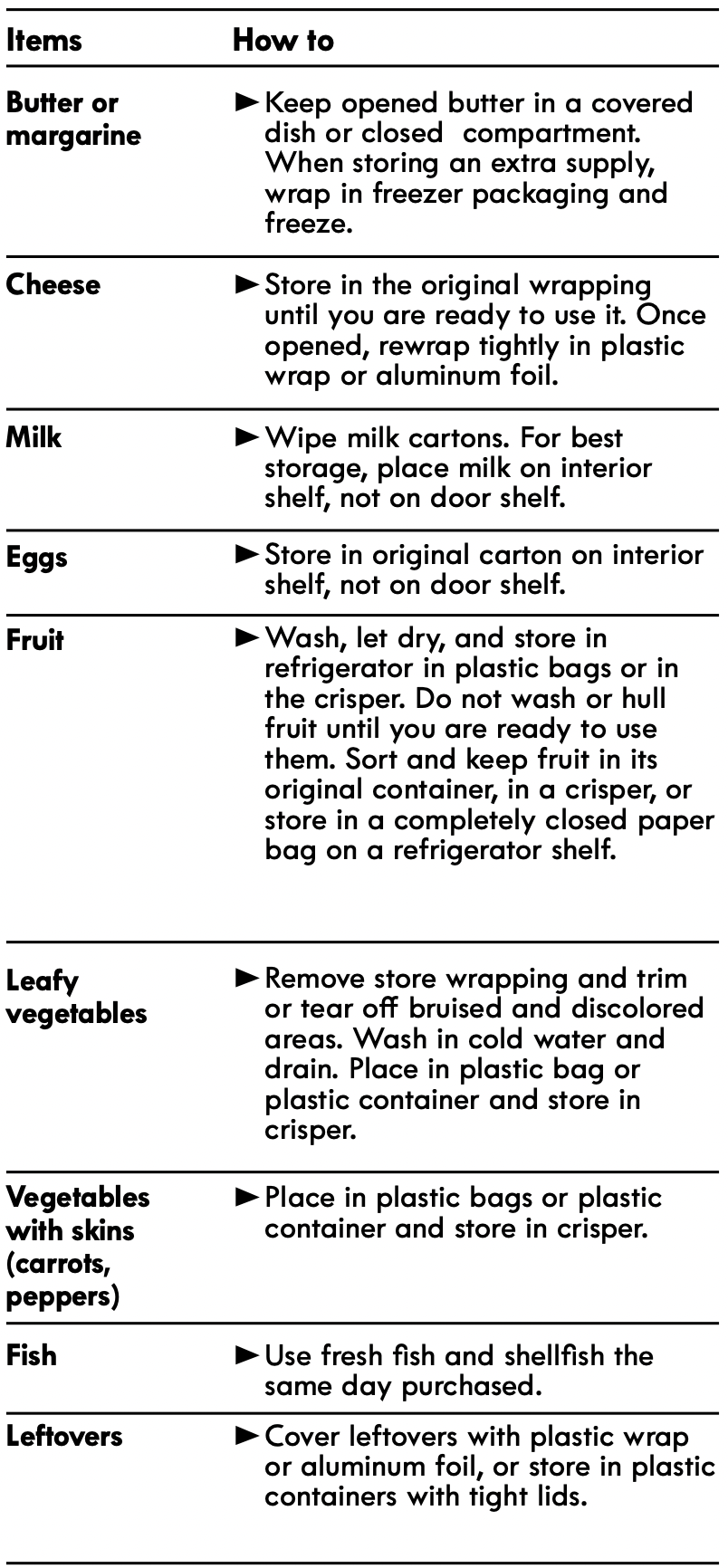
STORING FROZEN FOOD
NOTE: Check a freezer guide or a reliable cookbook for further information about preparing food for freezing or food storage times.
Freezing
Your freezer will not quick-freeze a large quantity of food. Do not put more unfrozen food into the freezer than will freeze within 24 hours (no more than 2 to 3 lbs. of food per cubic foot of freezer space). Leave enough space in the freezer for air to circulate around packages. Be careful to leave enough room at the front so the door can close tightly.
Storage times will vary according to the quality and type of food, the type of packaging or wrap used (how airtight and moisture-proof) and the storage temperature. Ice crystals inside a sealed package are normal. This simply means that moisture in the food and air inside the package have condensed, creating ice crystals.
NOTE: Allow hot foods to cool at room temperature for 30 minutes, then package and freeze. Cooling hot foods before freezing saves energy.
Packaging
Successful freezing depends on correct packaging. When you close and seal the package, it must not allow air or moisture in or out. If it does, you could have food odor and taste transfer throughout the refrigerator and could also dry out frozen food.
Packaging recommendations:
- Rigid plastic containers with tight-fitting lids
- Straight-sided canning/freezing jars
- Heavy-duty aluminum foil
- Plastic-coated paper
- Non-permeable plastic wraps
- Specified freezer-grade self-sealing plastic bags Follow package or container instructions for proper freezing methods.
Do not use
- Bread wrappers
- Non-polyethylene plastic containers
- Containers without tight lids
- Wax paper or wax-coated freezer wrap
- Thin, semi-permeable wrap
CAUTION: Do not keep beverage cans or plastic food containers in the freezer compartment. They may break or burst if they freeze.
REFRIGERATOR SECTION
WATER DISPENSER
To dispense cold water, push on the dispenser switch with a glass.
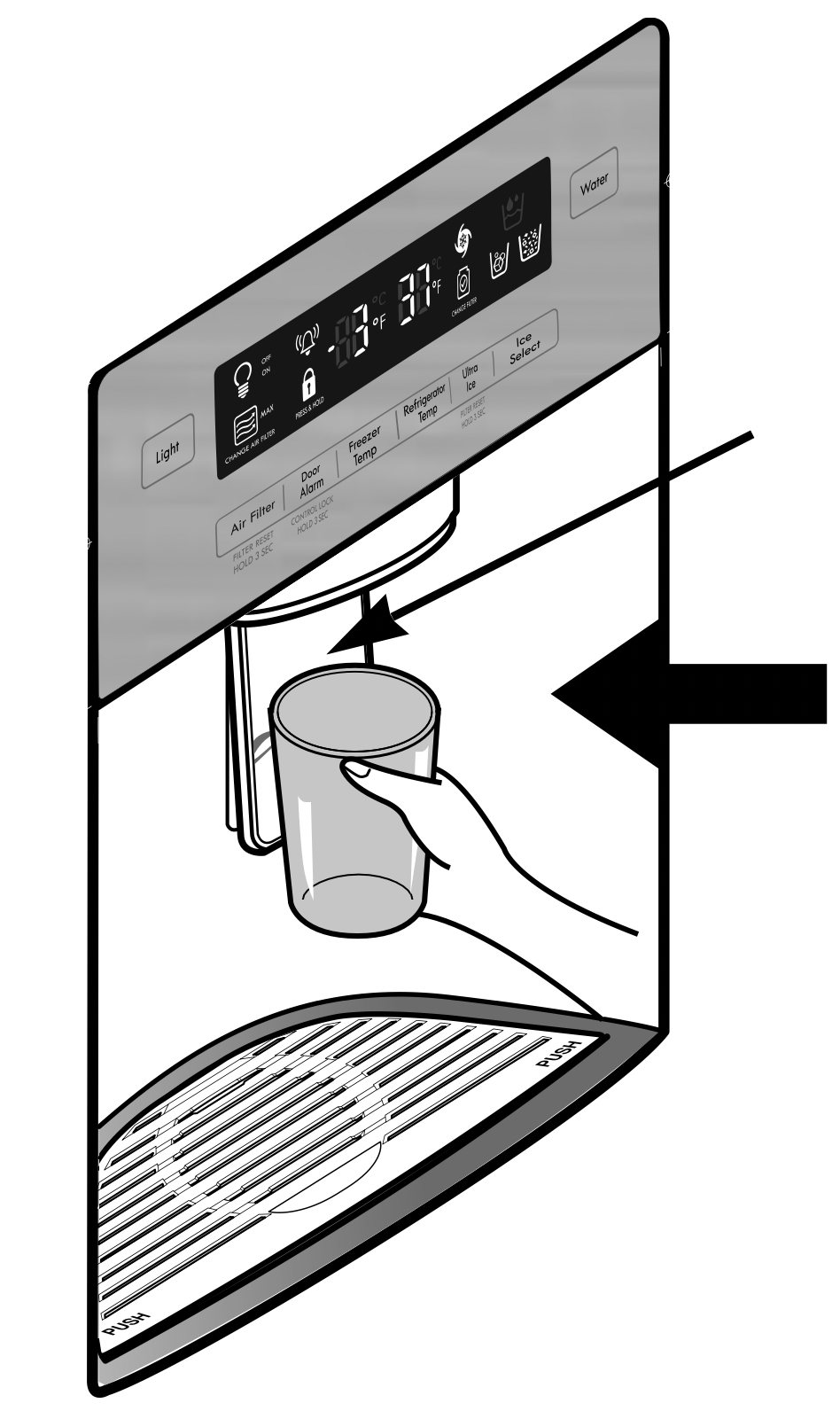
Some dripping may occur after dispensing. Hold your cup beneath the dispenser for a few seconds after dispensing to catch all of the drops.
Press down on either of the front corners to remove the tray.
Note: There is no drain beneath the tray. You may need to empty the tray of any liquid that collects in it.

NOTE: The dispenser is equipped with a light that turns on when the dispenser pad is engaged.
WARNING: Do not put your fingers up the ice chute opening. Doing so can result in severe injury.
CAUTION: Do not dispense ice into fine china or crystal glasses.
China or crystal can break.
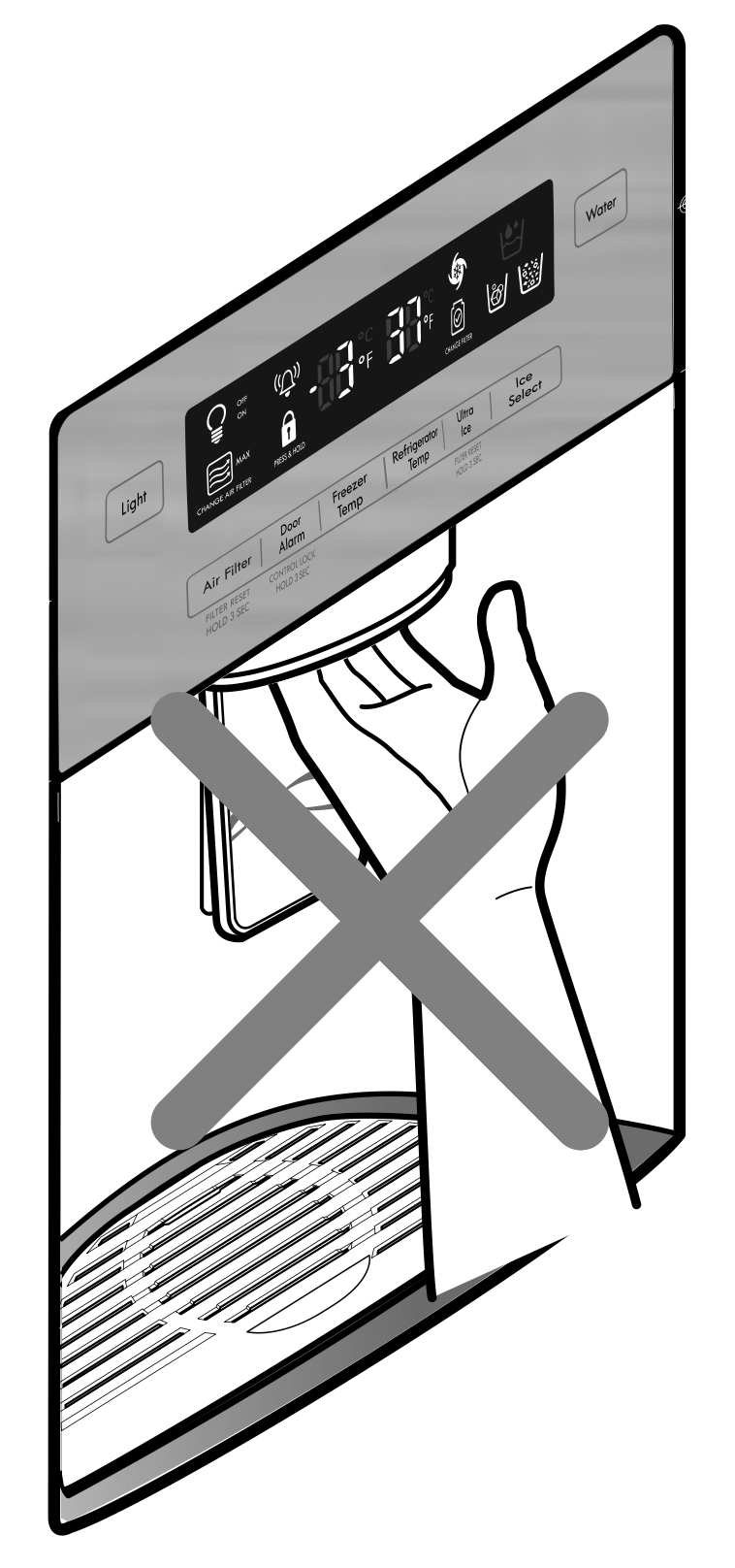
REFRIGERATOR SHELVES
The shelves in your refrigerator are adjustable to meet your individual storage needs. Your model may have glass or wire shelves.
Adjusting the shelves to fit items of different heights will make finding the exact item you want easier. Doing so will also reduce the amount of time the refrigerator door is open which will save energy.
IMPORTANT: Do not clean glass shelves with warm water while they are cold. Shelves may break if exposed to sudden temperature changes or impact.
NOTE: Glass shelves are heavy. Use special care when removing them.
Adjusting Shelves (Cantilever)
Remove shelves from the shipping position and replace shelves in the position you want.
To remove a shelf—Tilt up the front of the shelf 1 and lift it from below 2 . Pull the shelf out.
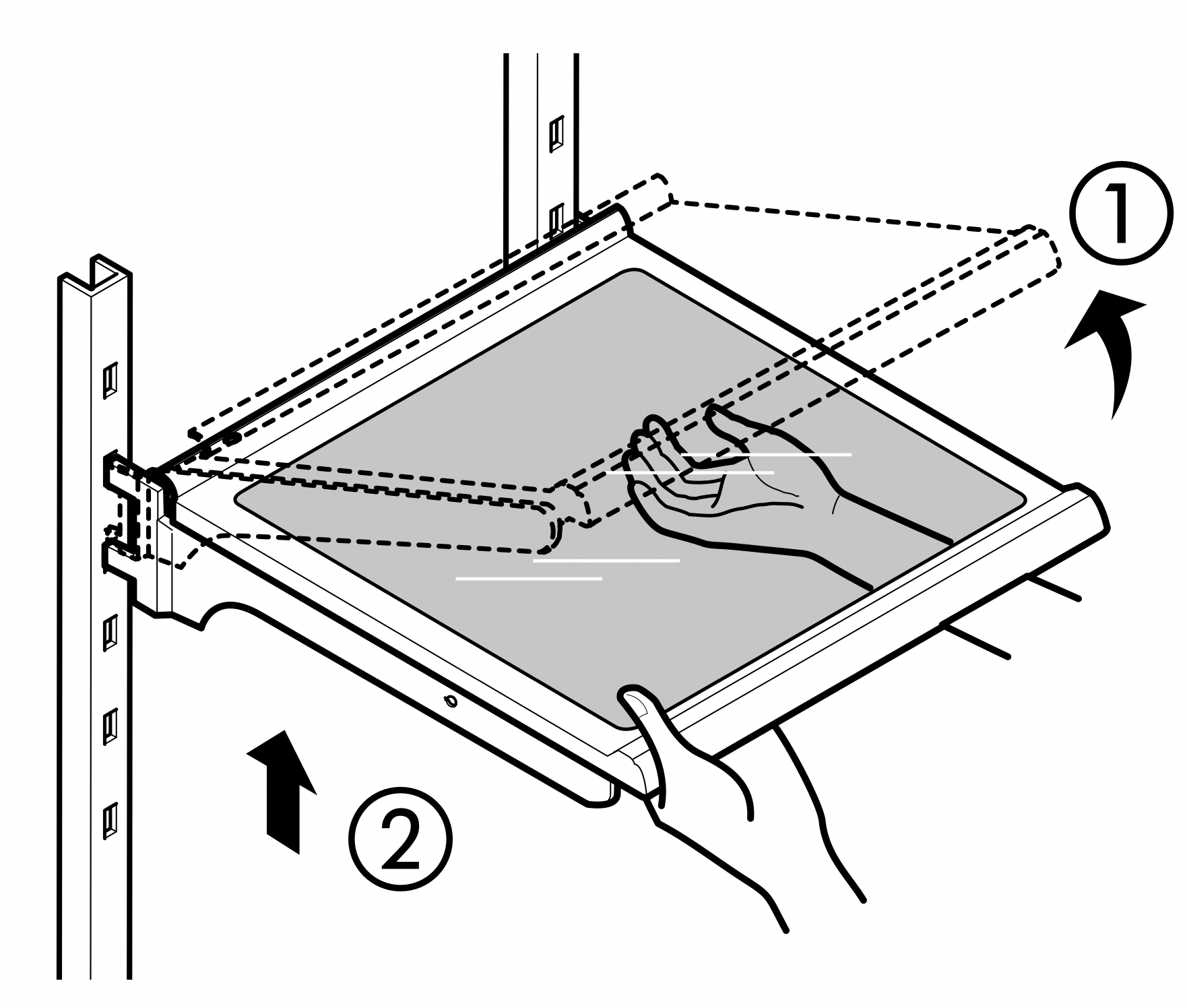
To reinstall a shelf—Tilt the front of the shelf up and guide the shelf hooks into the slots at a desired height. Then, lower the front of the shelf so that the hooks drop into the slots.

CAUTION: Make sure that shelves are level from one side to the other. Failure to do so may result in the shelf falling or spilling food.
Folding Shelf (on some models)
You can store taller items, such as a gallon container or bottles, by simply pushing the front half of the shelf underneath the back half of the shelf. Pull the front of the shelf toward you to return to a full shelf.
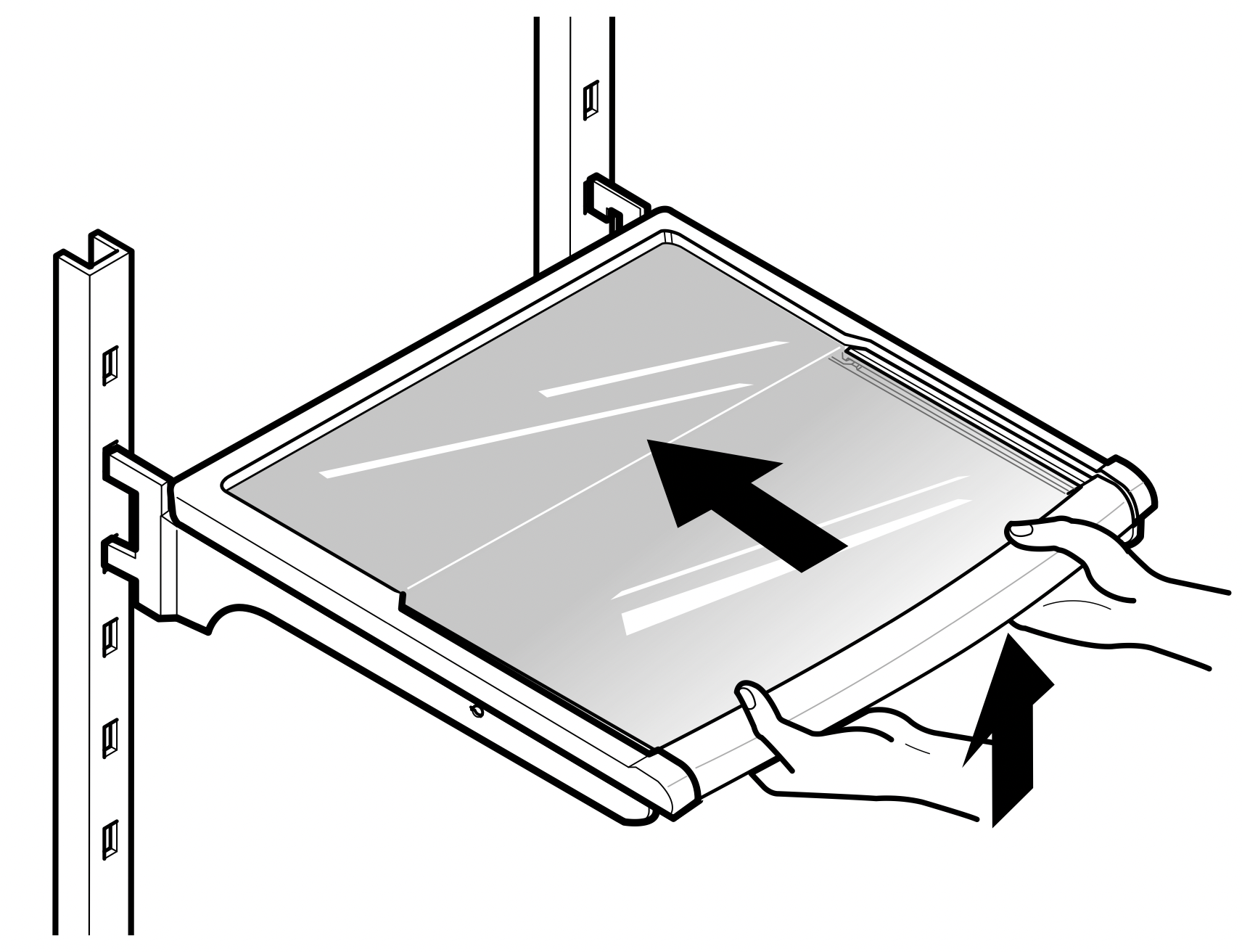
HUMIDITY CONTROLLED CRISPER
The crispers provide fresher tasting fruit and vegetables by letting you easily control humidity inside the drawer.
You can control the amount of humidity in the moisturesealed crispers by adjusting the control to any setting between VEGETABLE and FRUIT.
- VEGETABLE keeps moist air in the crisper for best storage of fresh, leafy vegetables.
- FRUIT lets moist air out of the crisper for best storage of fruit.

REMOVING THE HUMIDITY CONTROLLED CRISPER
- To remove, pull the drawer out to full extension.
- Lift the front of the crisper up, then pull it straight out.
- To install, slightly tilt up the front, insert the drawer into the frame and push it back into place.
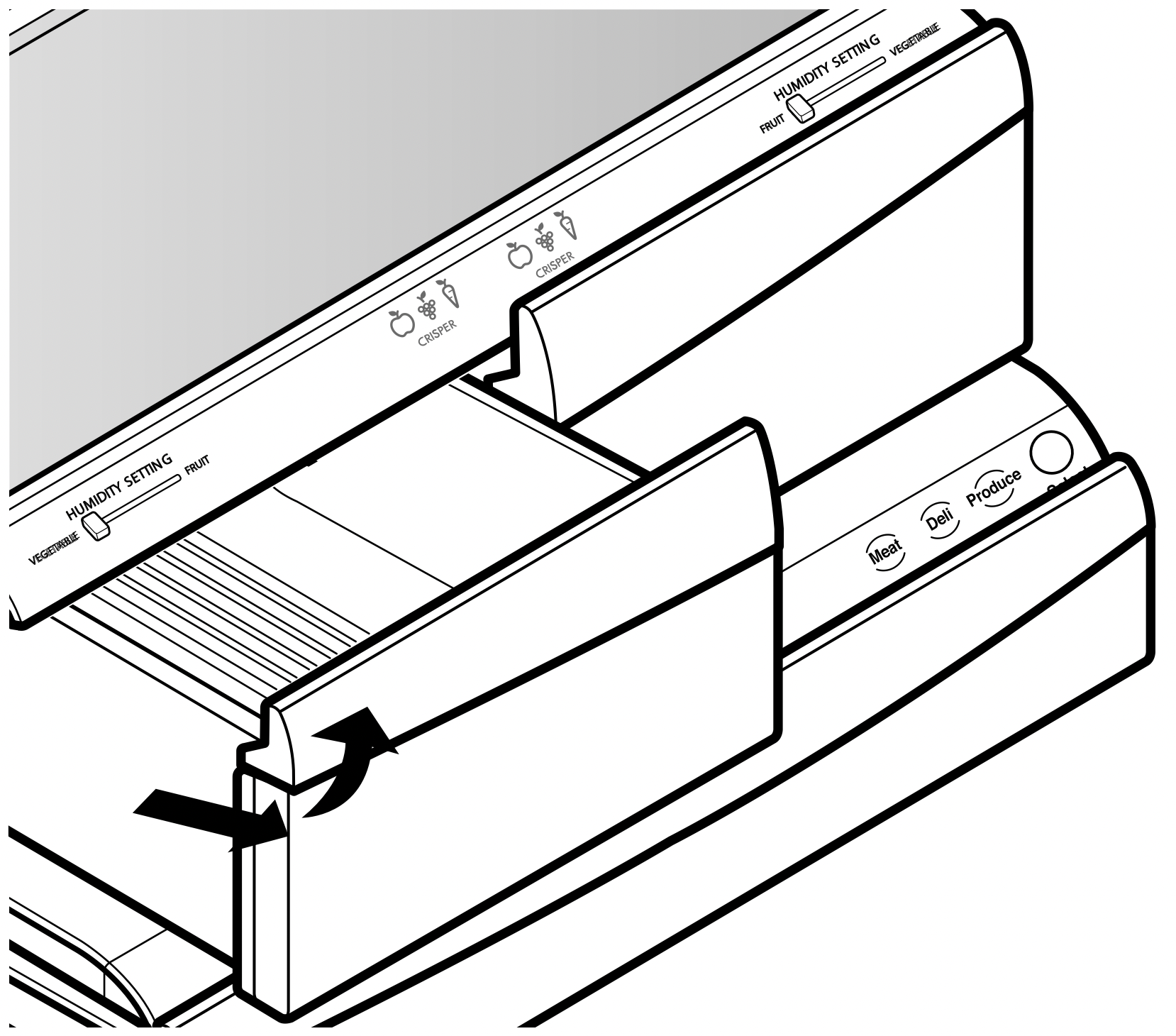
To remove the glass
- Lift up the glass under the crisper cover.
- Pull the glass up and out.
NOTE: Pantry drawer not shown for clarity.
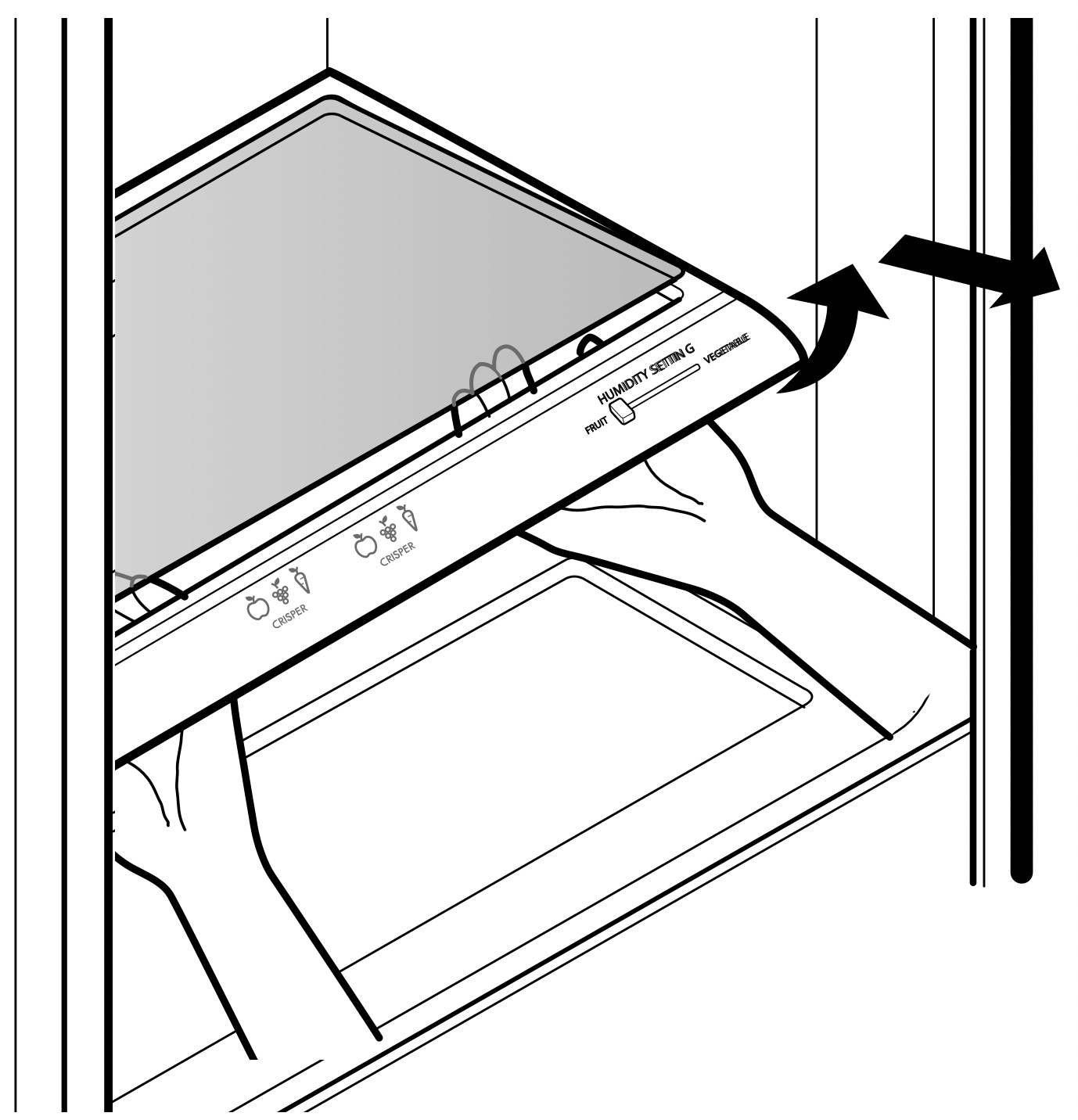
TEMPERATURE CONTROLLED PANTRY DRAWER
The Temperature Controlled Pantry Drawer provides storage space with a variable temperature control that can keep the compartment colder than the refrigerator section. This drawer can be used for large party trays, deli items and beverages. (This drawer should not be used for vegetables that require high humidity.)
Press the Select button to choose between Meat, Deli and Produce.

DOOR BIN
The door bins are removable for easy cleaning and adjustment.
- To remove the bin, simply lift the bin up and pull straight out.
- To replace the bin, slide it in above the desired support and push down until it snaps into place.
NOTE: Some bins may vary in appearance and will only fit in one location.

DAIRY BIN
- To remove the dairy bin, simply lift it and pull straight out.
- To replace the dairy bin, slide it into place and push down until it stops.

NOTE: The dairy bin will only fit in the top space on the right-hand door.
REPLACING THE AIR FILTER
It is recommended that you replace the air filter:

- Approximately every six months.
- When the CHANGE AIR FILTER light turns on.
- Remove the Old Filter
Turn the filter cover to the left to detach it from the refrigerator wall. The filter is located on the inside of the filter cover. Remove the filter from the cover and replace it with a new filter.
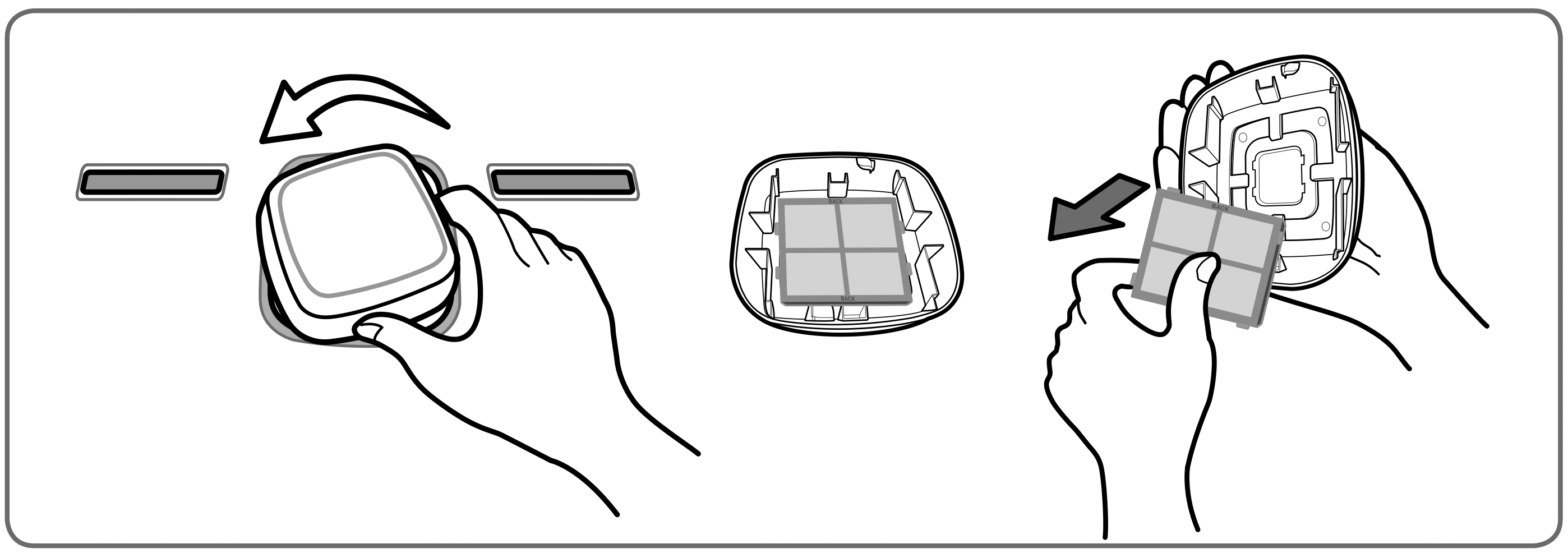
- Install a New Air Filter.
Place the new filter inside of the cover with the side that says “Front” facing outward. Turn the filter cover to the right to attach it to the refrigerator wall.

After changing the filter, press and hold the Air Filter button for three seconds to reset the filter sensor.
NOTE: To purchase a replacement air filter, visit a Sears store or call 1-800-4-MY-HOME® . Also, you may order on-line at www.sears.com/partsdirect.
FREEZER SECTION
EXTRA ICE BIN
- Pull the Freezer Drawer and the Pullout Drawer out as far as possible to remove the Extra Ice Bin.
- Gently lift and pull out the ice bin.
- To replace, pull both drawers out as far as possible, and set the bin in its correct position in the Pullout Drawer. Close the Pullout Drawer and then the Freezer Drawer.

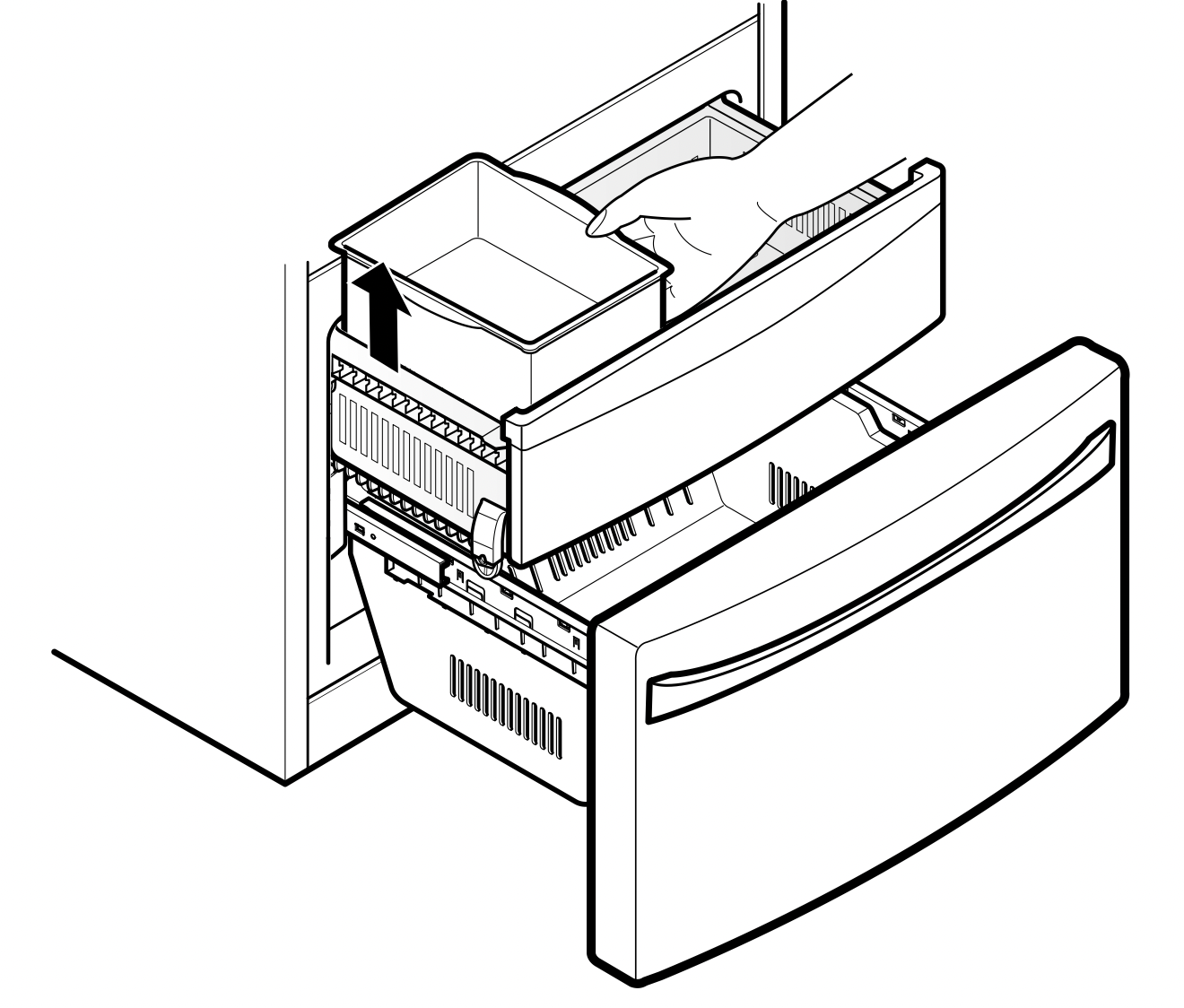
CAUTION: Pinch hazard! Keep hands and feet clear of the bottom of the freezer drawer when opening and closing.
DURABASE
- To remove the Durabase, push it to the back as much as possible. Tilt up the front of the Durabase and pull straight out.
- To replace, insert the Durabase in rail assembly.

DURABASE DIVIDER
The Durabase divider allows you to organize the Durabase area into sections. It can be adjusted from side to side to accommodate items of different sizes.
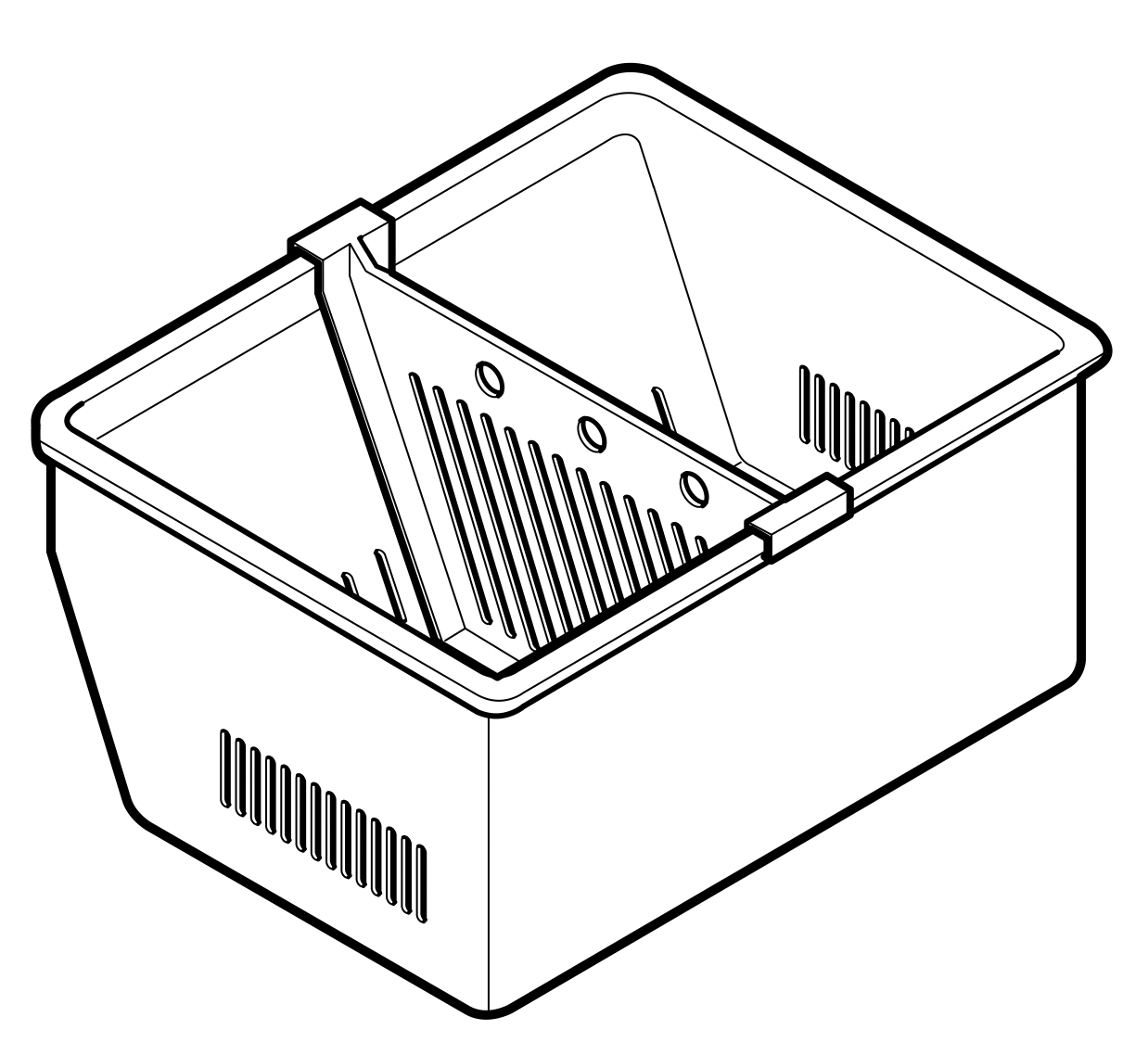
WARNING: If the Durabase divider is removed, there is enough open space for children or pets to crawl inside. To prevent accidental child and pet entrapment or suffocation risk, DO NOT allow children or pets to touch or go near the drawer.
PULLOUT DRAWER
- To remove, pull the drawer out to full extension. Lift the front of the drawer up, then pull it straight out.

- To replace, slightly tilt up the drawer front, insert the drawer into the frame, and push the drawer back into place.
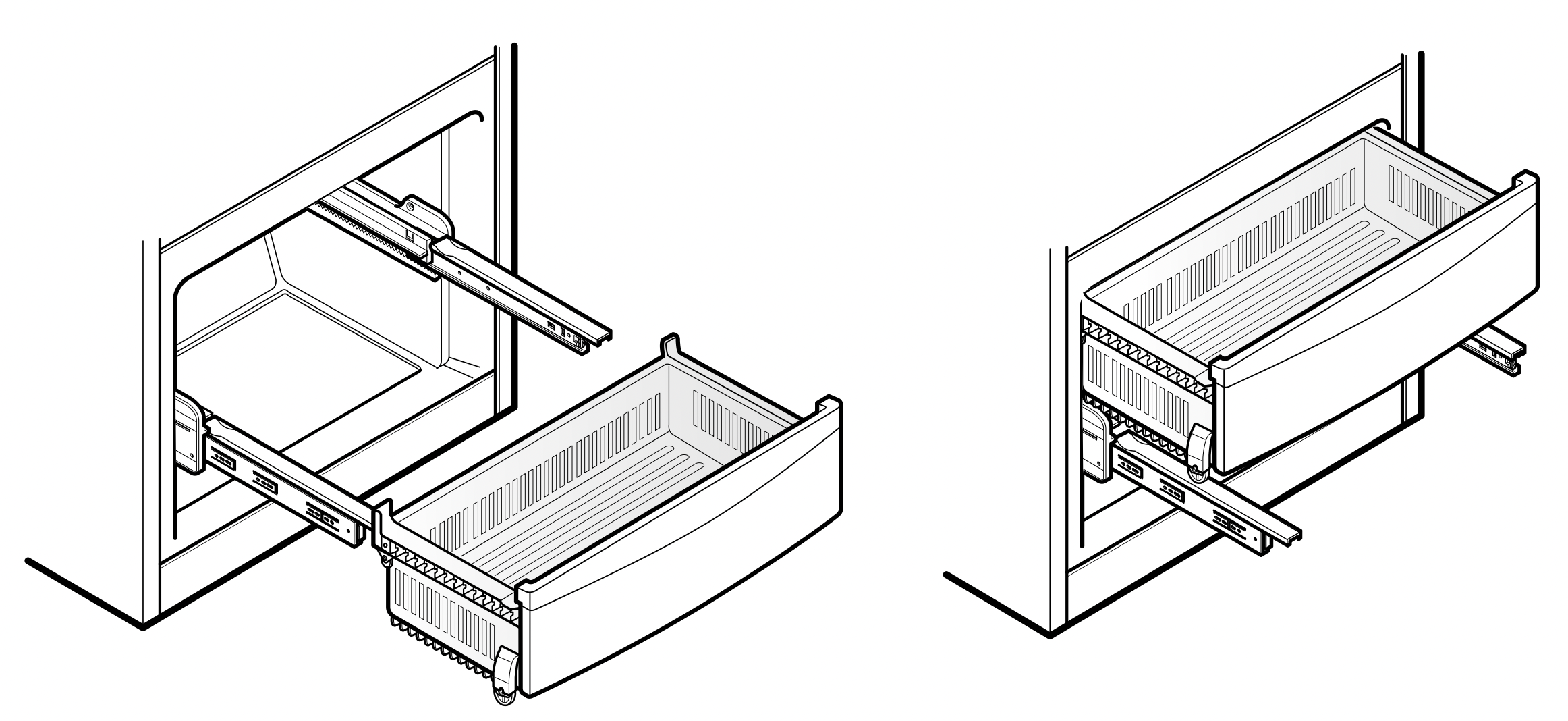
WATER FILTER
WATER FILTER 
It is recommended that you replace the water filter:
- Approximately every 6 months.
- When the water filter indicator turns on.
- When the water dispenser output decreases.
- When the ice cubes are smaller than normal.

- Remove the old water filter.
Lower or remove the top left shelf to allow the water filter to rotate all the way down.
Press the push button to open the water filter cover.

NOTE: Replacing the water filter causes a small amount of water (around 1 oz. or 25 cc) to drain. Place a cup under the front end of the water filter cover to collect any leaking water. Hold the water filter upright, once it is removed, to prevent any remaining water from spilling out of the water filter.
Pull the water filter downward and pull out. Make sure to rotate the filter down completely before pulling it out of the manifold hole.

- Replace with a new water filter.
Take the new water filter out of its packing and remove the protective cover from the o-rings. With water filter tabs in the horizontal position, push the new water filter into the manifold hole until it stops.
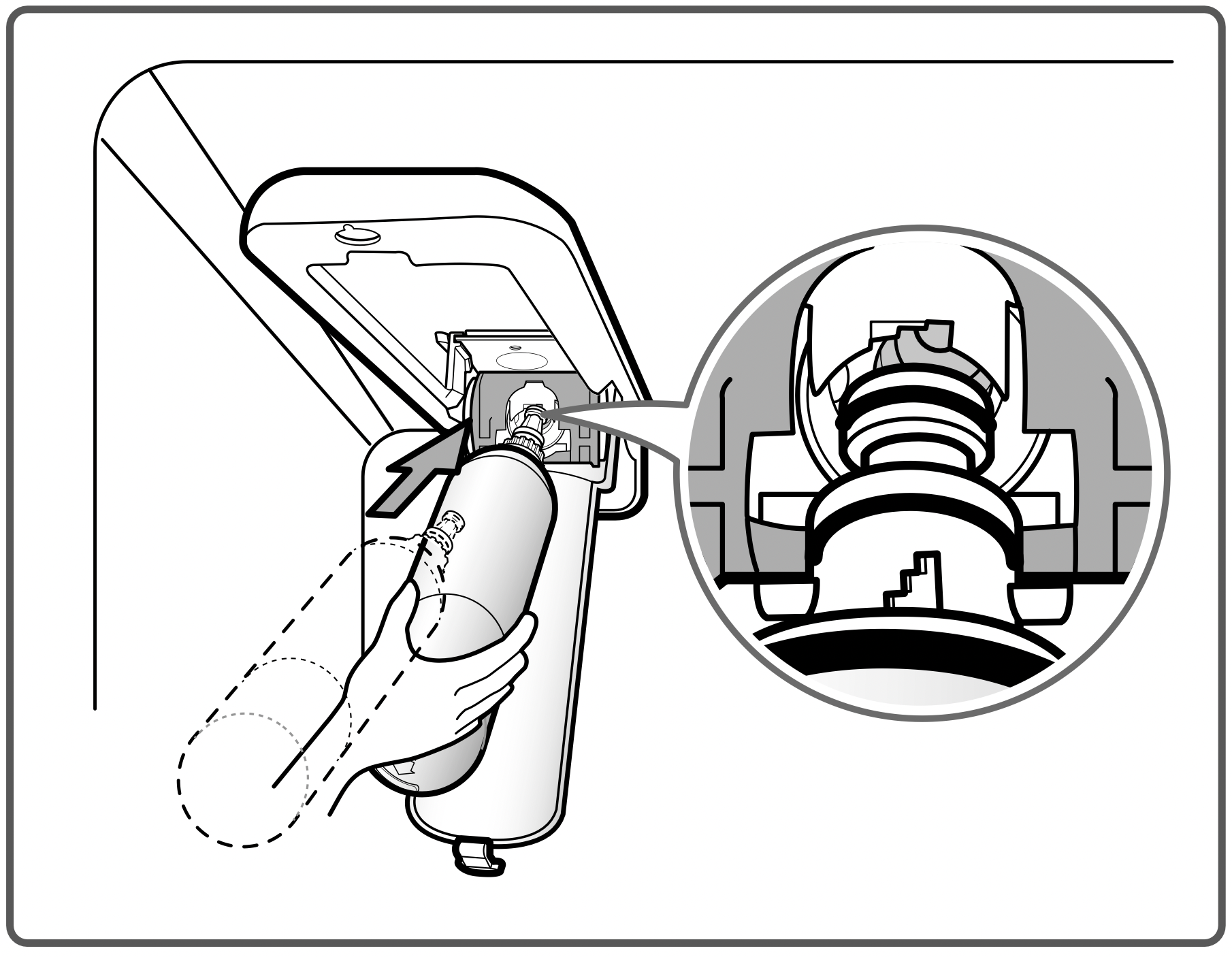
Rotate the water filter up into position and close the cover. The cover will click when closed correctly.
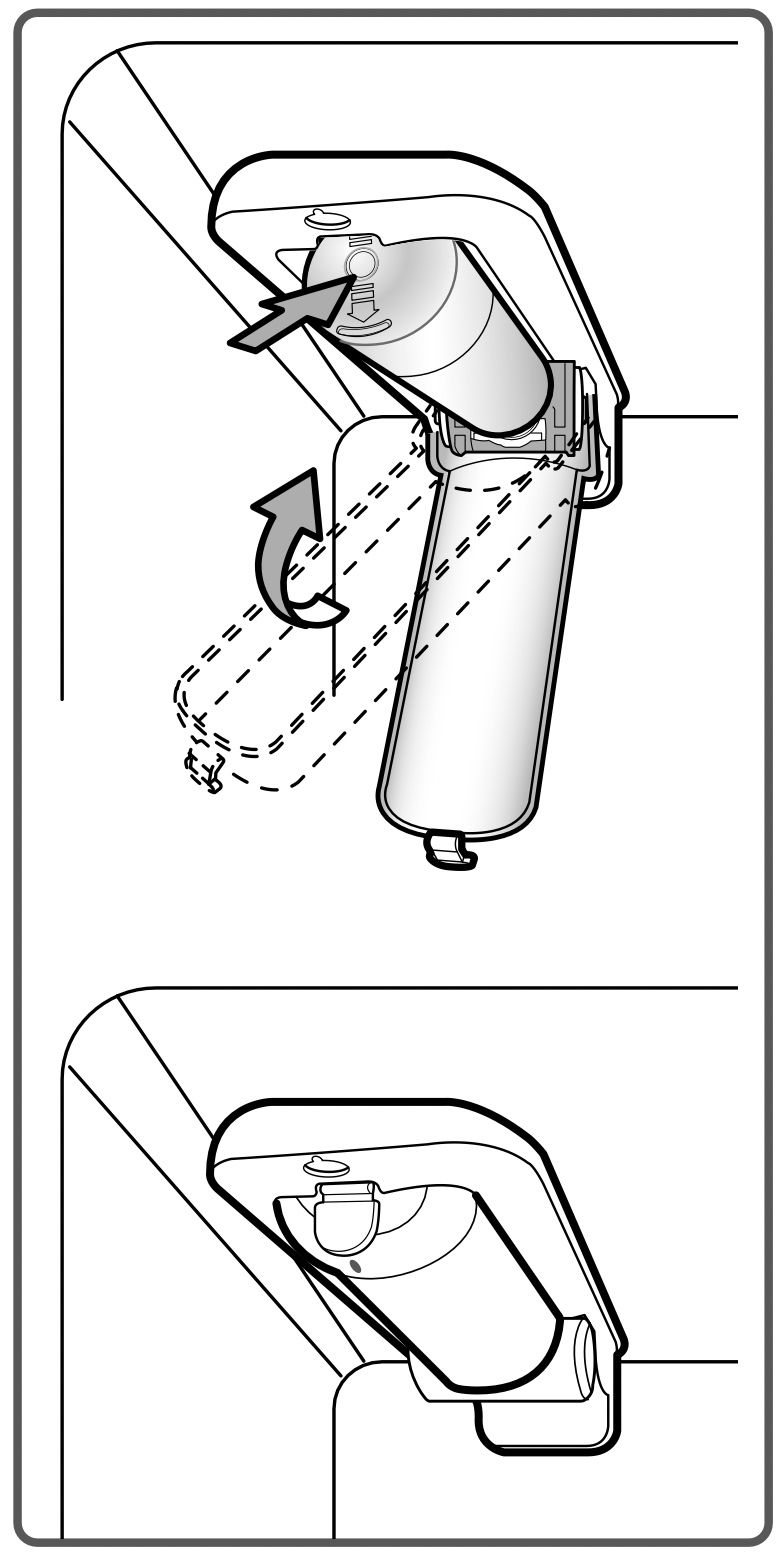
- After the water filter is replaced, dispense 2.5 gallons of water (flush for approximately 5 minutes) to remove trapped air and contaminants from the system. Do not dispense the entire 2.5 gallon amount continuously. Depress and release the dispenser pad for cycles of 30 seconds ON and 60 seconds OFF.
- Water Filter Bypass Plug
Keep the water filter bypass plug. You MUST use the water filter bypass plug when a replacement water filter cartridge is not available.
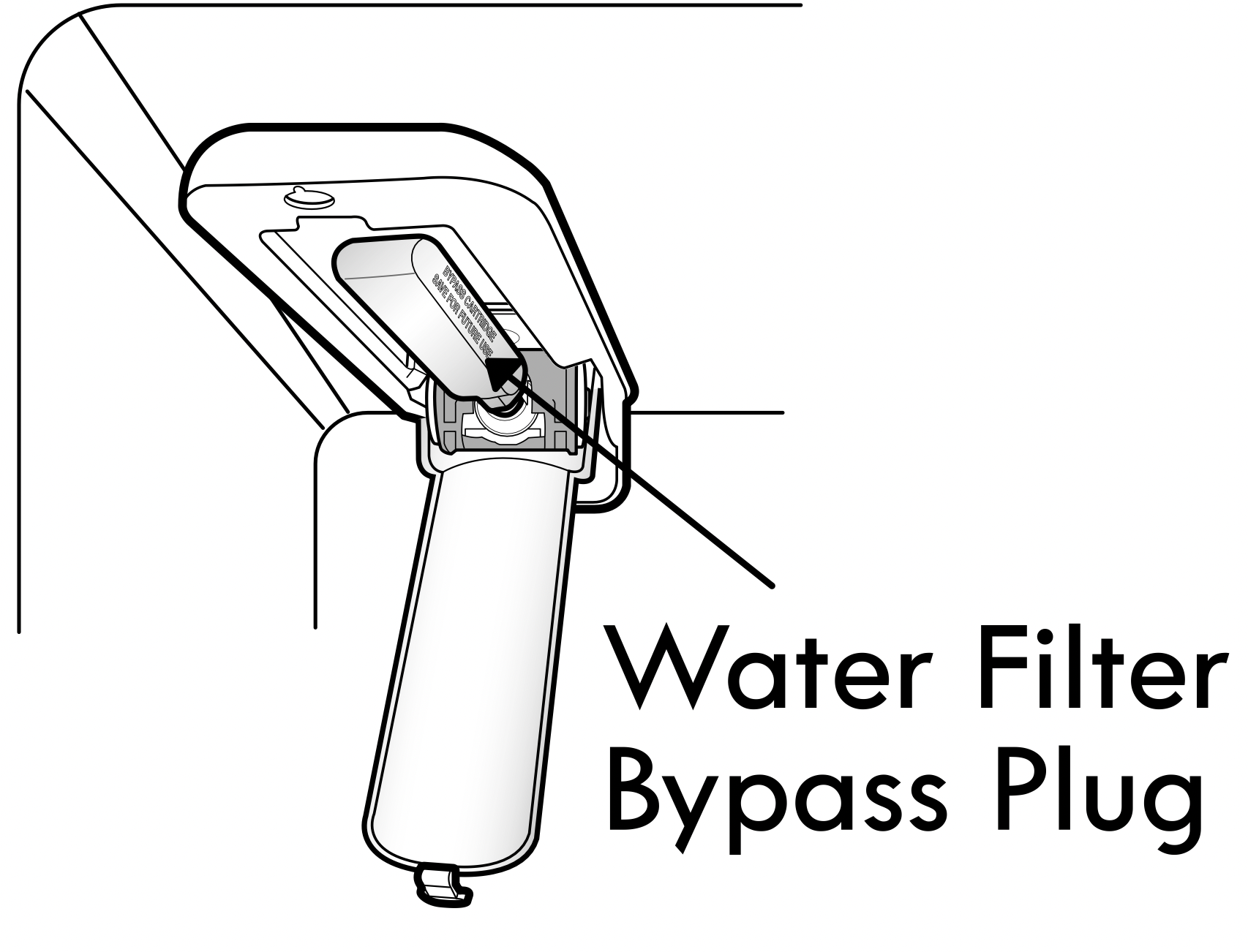
CAUTION: DO NOT operate the refrigerator without the water filter or water filter plug installed.
CAUTION
To reduce the risk associated with property damage due to water leakage:
- Read and follow the Water Filter instructions before installation and use of this system.
- Installation and use MUST comply with all state and local plumbing codes.
- Do not install if water pressure exceeds 120 psi (827 kPa). Contact a plumbing professional if you are uncertain of how to check your water pressure.
- Do not install where water hammer conditions may occur. If water hammer conditions exist, you must install a water hammer arrester. Contact a plumbing professional if you are uncertain of how to check for this condition.
- Do not install on hot water supply lines.
The maximum operating water temperature of this water filter system is 100°F (38°C). - Protect water filter from freezing. Do no operate refrigerator in ambient conditions below 55°F. Drain water filter when storing unit in temperatures below 40°F (4.4°C).
- The disposable water filter must be replaced every six months, at the rated capacity, or if a noticeable reduction in flow rate occurs.
CARE AND CLEANING
WARNING - Explosion Hazard: Use non-flammable cleaner. Failure to do so can result in fire, explosion, or death.
Both the refrigerator and freezer sections defrost automatically; however, clean both sections about once a month to prevent odors. Wipe up spills immediately.
GENERAL CLEANING TIPS
- Unplug the refrigerator or disconnect power.
- Remove all removable parts, such as shelves, crispers, etc. Refer to the sections in Using Your Refrigerator for removal instructions.
- Use a clean sponge or soft cloth and a mild detergent in warm water. Do not use abrasive or harsh cleaners.
- Hand wash, rinse and dry all surfaces thoroughly.
- Plug in the refrigerator or reconnect power.
OUTSIDE
Waxing external painted metal surfaces helps provide rust protection. Do not wax plastic parts. Wax painted metal surfaces at least twice a year using appliance wax (or auto paste wax). Apply wax with a clean, soft cloth.
For products with a stainless steel exterior, use a clean sponge or soft cloth and a mild detergent in warm water. Do not use abrasive or harsh cleaners. Dry thoroughly with a soft cloth.
INSIDE WALLS (allow freezer to warm up so the cloth will not stick)
To help remove odors, you can wash the inside of the refrigerator with a mixture of baking soda and warm water. Mix 2 tablespoons of baking soda to 1 quart of water (26 g soda to 1 liter water.) Be sure the baking soda is completely dissolved so it does not scratch the surfaces of the refrigerator.
CAUTION: While cleaning the inside, do not spray water.
DOOR LINERS AND GASKETS
Use a clean sponge or soft cloth and a mild detergent in warm water. Do not use cleaning waxes, concentrated detergents, bleaches, or cleaners containing petroleum on plastic refrigerator parts.
PLASTIC PARTS (Covers and Panels)
Use a clean sponge or soft cloth and a mild detergent in warm water. Do not use window sprays, abrasive cleansers, or flammable fluids. These can scratch or damage the material.
CONDENSER COILS
Use a vacuum cleaner with an attachment to clean the condenser cover and vents. Do not remove the panel covering the condenser coil area.

LIGHT BULB REPLACEMENT
WARNING - Electrical Shock Hazard: Before replacing a Compartment Lamp, either unplug the refrigerator or turn off power at the circuit breaker or fuse box.
NOTE: The refrigerator and freezer compartment lights are LED interior lighting, and service should be performed by a qualified technician.
POWER INTERRUPTIONS
- If the power will be out for 24 hours or less, keep all refrigerator doors closed to help foods stay cold and frozen.
- If the power will be out for more than 24 hours, remove all frozen food and store it in a frozen food locker.
WHEN YOU GO ON VACATION
If you choose to leave the refrigerator on while you are away, follow these steps to prepare your refrigerator before you leave.
- Use up any perishables and freeze other items.
- Turn off the icemaker and empty the ice bin.
If you choose to turn the refrigerator off before you leave, follow these steps.
- Remove all food from the refrigerator.
- Depending on your model, set the thermostat control (refrigerator control) to OFF. See the Setting the Controls section.
- Clean the refrigerator, wipe it and dry well.
- Tape rubber or wood blocks to the tops of both doors to prop them open far enough for air to get in. This stops odor and mold from building up.
WHEN YOU MOVE
When you are moving your refrigerator to a new home, follow these steps to prepare it for the move.
- Remove all food from the refrigerator and pack all frozen food in dry ice.
- Unplug the refrigerator.
- Clean, wipe and dry thoroughly.
- Take out all removable parts, wrap them well and tape them together so they do not shift and rattle during the move. Refer to the Using your Refrigerator section for removal instructions.
- Depending on the model, raise the front of the refrigerator so it rolls more easily OR screw in the leveling legs all the way so they do not scrape the floor. See the Door Closing section.
- Tape the doors shut and tape the power cord to the refrigerator cabinet.
When you get to your new home, put everything back and refer to the Refrigerator Installation section for preparation instructions.
TROUBLESHOOTING GUIDE
UNDERSTANDING SOUNDS YOU MAY HEAR
Your new refrigerator may make sounds that your old one did not make. Most of the new sounds are normal. Hard surfaces, like the floor, walls and cabinets, can make the sounds seem louder than they actually are. The following describes the kinds of sounds you may hear and what may be causing them.
Clicking: The defrost control will click when the automatic defrost cycle begins and ends. The thermostat control (or refrigerator control, depending on the model) will also click when cycling on and off.
Rattling: Rattling noises may come from the flow of refrigerant, the water line, or items stored on top of the refrigerator.
Whooshing:
- Evaporator fan motor circulating the air through the refrigerator and freezer compartments.
- Air being forced over the condenser by the condenser fan.
- Ice compartment fan in the freezer on the left side of the refrigerator when the doors are open.
Gurgling: As each cycle ends, you may hear a gurgling sound caused by the refrigerant flowing through the cooling system.
Popping: Contraction and expansion of the inside walls.
Sizzling: Water dripping on the defrost heater during a defrost cycle.
Vibrating Noise: If the side or back of the refrigerator is touching a cabinet or wall, some of the normal vibrations may make an audible sound. To eliminate the noise, make sure that the sides and back cannot vibrate against any wall or cabinet.
Dripping: Water running into the drain pan during the defrost cycle.
Pulsating or High-Pitched Sound: Your refrigerator is designed to run more efficiently to keep your food items at the desired temperature. The high efficiency compressor may cause your new refrigerator to run longer than your old one, but is still more energy efficient than previous models. While the refrigerator is running, it is normal to hear a pulsating or high-pitched sound.
|
Problem |
Possible Causes | Solutions |
|---|---|---|
| Refrigerator is not cooling. |
The power supply cord is unplugged. |
Firmly plug the cord into a live outlet with proper voltage (see Electrical & Grounding Requirements). |
|
A household fuse has blown or a circuit breaker has tripped. |
Replace the fuse or reset the circuit breaker. If the problem persists, contact an electrician. |
|
|
The refrigerator control is set to the OFF position. |
Refer to the Setting the Controls section. |
|
|
The refrigerator is in the defrost cycle. |
Wait about 30 minutes for defrost cycle to end. |
|
|
The refrigerator is in Demo Mode.
|
The Demo Mode allows the lights and control display to work normally while disabling the cooling system to save energy while on the showroom floor. To disable Demo Mode, open one door, then press and hold the Ultra Ice and Refrigerator Temp. buttons for five seconds. Once disabled, OFF will disappear and the previous temperature settings will be displayed (refer to Setting the Controls for recommended temperatures). |
|
|
Lights donot work. |
The power supply cord is unplugged. Interior lights have malfunctioned. |
Firmly plug the cord into a live outlet with proper voltage (refer to Electrical & Grounding Requirements). The interior lights are LED lighting, and repair service must be performed by a qualified technician. |
|
Vibration or rattling noise. |
The refrigerator isnot resting solid lyon the floor. |
Floor is weak or uneven or leveling legs need adjusting. See the Installation section for leveling instructions. |
|
Compressor seems to run too much. |
The refrigerator that was replaced was a nolder model. |
Modern refrigerators require more operating time but use less energy due to more efficient technology. |
|
The room temperature is warmer than normal. |
The compressor will run longer under warm conditions. At normal room temperatures (70°F) expect your compressor to run about 40% to 80% of the time. Under warmer conditions, expect it to run even more often. The refrigerator should not be operated above 110°F. |
|
|
The door is opened often or a large amount of food has just been added. |
Adding food and opening the door warms the refrigerator, requiring the compressor to run longer in order to cool the refrigerator back down. In order to conserve energy, try to get everything you need out of the refrigerator at once, keep food organized so it is easy to find, and close the door as soon as the food is removed. Refer to the Food Storage Guide. |
|
|
The refrigerator was recently plugged in and the refrigerator control was set correctly. |
The refrigerator will take up to 24 hours to cool completely. |
|
|
The refrigerator control is not set correctly for the surrounding conditions. |
See the Adjusting Control Settings section. |
|
|
The doors are not closed completely. |
Firmly push the doors shut. If they will not shut all the way, see “Doors will not close completely” in the Troubleshooting section. |
|
|
The back cover is dirty. |
This prevents air transfer and makes the motor work harder. Clean the back cover. Refer to the Care and Cleaning section. |
|
|
The refrigerator seems to make too much noise. |
The sounds may be normal for your refrigerator. |
Refer to the Understanding Sounds You May Hear section for more information. |
|
Doors will not close completely. |
The refrigerator is not level. |
See the Leveling and Door Alignment section. |
|
Food packages are blocking the door open. |
Rearrange food containers to clear door and door shelves. |
|
|
The ice bin, crisper cover, pans, shelves, door bins or baskets are out of position. |
Push bins all the way in and put crisper cover, pans, shelves and baskets into their correct positions. See the Using Your Refrigerator section for more information. |
|
|
The gaskets are sticking. |
Clean gaskets and the surfaces that they touch. Rub a thin coat of appliance polish or kitchen wax on the gaskets after cleaning. |
|
|
The refrigerator wobbles or seemsunstable. |
Level the refrigerator. Refer to the Leveling and Door Alignment section for more information. |
|
|
The doors were removed during product installation and not properly replaced. |
Remove and replace the doors according to the Removing and Replacing Refrigerator Handles and Doors section, or call a qualified technician. |
|
|
Articulating Mullion is out of position. |
Rotate the articulating mullion to the closed position and reattempt to shut the door. Refer to Refrigerator Features for more information on the articulating mullion. |
|
|
Frost or ice crystals on frozen food. |
The door is not closing properly. |
See “Doors will not close completely” in the Troubleshooting section. |
|
The door is opened often. |
When the door is opened, warm, humid air is allowed in the freezer, resulting in frost. |
|
|
Ice has bad taste or odor. |
The icemaker was recently installed. |
Discard the first few batches of ice to avoid discolored or bad tasting ice. |
|
The ice has been stored for too long. |
Throw away old ice and make a new supply. |
|
|
The food has not been wrapped tightly in either compartment. |
Rewrap foods since odors may migrate to the ice if food is not wrapped properly. |
|
|
The water supply contains minerals such as sulfur. |
A water filter may need to be installed to eliminate taste and odor problems. |
|
|
The interior of the refrigerator needs cleaning. |
See the Care and Cleaning section for more information. |
|
|
The ice storage bin needs cleaning. |
Empty and wash bin. Discard old cubes. |
|
|
There is water in the defrost drain pan. |
The refrigerator is defrosting. |
The water will evaporate. It is normal for water to drip into the defrost pan. |
|
It is more humid than normal. |
Expect that the water in the defrost pan will take longer to evaporate.This is normal when it is hot or humid. |
|
|
The icemaker is not producing ice or not enough ice. |
New installation. |
Wait 12 to 24 hours after icemaker installation for ice production to begin.Wait 72 hours for full ice production. |
|
The refrigerator is not connected to a water supply or the supply shutoff valve is not turned on. |
Connect the refrigerator to the water supply and turn the water shutoff valve fully open. |
|
|
Reverse osmosis water filtration system is connected to your cold water supply. |
Reverse osmosis filtration systems can reduce the water pressure below the minimum amount and result in icemaker issues. Refer to the Water Pressure section. |
|
|
Kink in the water source line. |
A kink in the line can reduce water flow. Straighten the water source line. |
|
|
Ice demand has exceeded storage capacity. |
The icemaker will produce approximately 100 cubes in a 24 hour period. NOTE: An extra ice bucket is provided in the freezer section for additional storage capacity. |
|
|
The icemaker is not turned on. |
Locate the icemaker ON/OFF switch and confirm it is in the ON (I) position. |
|
|
There is something on the ice-detecting sensor. |
Foreign substances or frost on the ice-detecting sensor can interrupt ice production. Make sure the sensor area is clean at all times for proper operation. |
|
|
The temperature setting forthe freezer is too warm. |
The recommended temperature for the freezer compartment for normal ice production is 0°F. If the freezer temperature is warmer, ice production will be affected. |
|
|
The doors are opened often. |
If the doors of the unit are opened often, ambient air will warm the refrigerator which will prevent the unit from maintaining the set temperature. Lowering the refrigerator temperature can help, as well as not opening the doors as frequently. |
|
|
The doors are not closing properly. |
If the doors are not properly closed, ice production will be affected. See “Doors will not close completely” in the Troubleshooting section for more information. |
|
|
The ice compartment door is not closing properly. |
If the ice compartment door is not properly closed, ice production will be affected. Make sure that the ice compartment door is closed for proper operation. Refer to the Refrigerator Features section. |
|
|
Ultra Ice is not selected. |
Ultra Ice increases ice production by lowering the freezer compartment temperature. Refer to Setting the Controls for more information. |
|
|
Not dispensing ice. |
Not all of the doors are closed completely. |
Ice will not dispense if any of the refrigerator doors are left open. |
|
The dispenser display is locked. |
Press and hold the Lock button for 3 seconds to unlock the control panel and dispenser. |
|
|
Ice is not selected on the dispenser. |
The dispenser can be set for ice or water. Make certain that the control panel is set for the proper operation. Press the Ice Select button on the control panel to cycle through the ice options. |
|
|
The ice dispenser is not used often. |
Infrequent use of the ice dispenser will cause the cubes to stick together overtime, which will prevent them from properly dispensing. Check the ice bin for ice cubes clumping/ sticking together. If they are, break up the ice cubes to allow for proper operation. |
|
|
Ice bin is not installed correctly. |
Be sure to correctly install the ice bin into position. Refer to Using your Refrigerator for removal and installation instructions. |
|
|
New installation. |
Wait 12 to 24 hours after icemaker installation for ice production to begin. Wait 72 hours for full ice production. |
|
|
The delivery chute is clogged with frost or ice fragments. |
Eliminate the frost or ice fragments by removing the ice bin and clearing the chute with a plastic utensil. Dispensing cubed ice can also help prevent frost or ice fragment buildup. |
|
|
Dispensing warm water. |
New installation. |
Allow 24 hours after installation for the water storage tank to cool completely. |
|
The water dispenser has been used recently and the storage tank was exhausted. |
The unit has a 12 oz water storage tank inside the refrigerator. |
|
|
The refrigerator is connected to a hot water line. |
Make sure the refrigerator is connected to a cold water pipe. |
|
|
Refrigerator or Freezer section is too cold. |
Controls are not set correctly for conditions. |
If the temperature is too cold, raise the temperature setting one increment at a time (refer to the Setting the Controls section). When changing control settings, wait 24 hours before making additional adjustments. |
|
Not dispensing water. |
The dispenser panel is locked. |
Press and hold the Lock button for 3 seconds to unlock the control panel and dispenser. |
|
New installation. |
Flush and fill the water system. |
|
|
Refrigerator or freezer doors are not closed properly. |
Water will not dispense if any of the refrigerator doors are left open. |
|
|
The refrigerator is not connected to a water supply or the supply shutoff valve is not turned on. |
Connect the refrigerator to the water supply and turn the water shutoff valve fully open. |
|
|
Home filter or reverse osmosis system is used. |
This can decrease water pressure. For optimal operation, do not connect the supply line to a reverse osmosis system. Refer to the Water Pressure section. |
|
|
The dispenser is not set for water dispensing. |
The dispenser can be set for ice or water. Make certain that the control panel is set for the proper operation. Press the Water button on the control panel to dispense water. |
|
|
The water filter needs to be changed. |
The water filter should be changed every 6 months or more often depending on usage. The water filter can become blocked over time with foreign particles and reduce the water pressure. |
|
|
The doors are difficult to open. |
The gaskets are dirty or sticky. |
Clean the gaskets and the surfaces that they touch. Rub a thin coat ofappliance polish or kitchen wax on the gaskets after cleaning. |
|
The door is reopened within a short time after having been opened. |
When you open the door, warmer air enters the refrigerator. As the warm air cools, it can create a vacuum. If the door is hard to open, wait one minute to allow the air pressure to equalize, then see if it opens more easily. |
|
|
Frozen food in refrigerator compartment. |
The temperature control in the refrigerator compartment is set too cold. |
Press the Refrigerator Temp. button to set the refrigerator compartment to a warmer temperature. |
|
Refrigerator is installed in a cold location. |
When room temperature is below 41°F (5°C), food can freeze. The refrigerator should not be operated in temperatures below 55°F (13°C). |
|
|
Food with a high water content was placed too close to the cold air discharge vent. |
Place food with a high water content toward the front of the refrigerator. |
|
| Temperature is too warm or there is interior moisture buildup. |
The air vents are blocked. Cold air circulates from the freezer to the fresh food section and back again through air vents in the wall dividing the two sections. |
Locate air vents by using your hand to sense airflow and move all packages that block vents and restrict airflow. (See air flow diagram below.)
|
| The doors are opened often. |
Opening the door warms the refrigerator, requiring the compressor to run longer in order to cool the refrigerator back down. In order to conserve energy, try to get everything you need out of the refrigerator at once, keep food organized so it is easy to find, and close the door as soon as the food is removed. |
|
|
The control is not set correctly for the surrounding conditions. |
If the temperature is too warm, change the setting one increment at a time (see the Adjusting Control Settings section). Refer to the Setting the Controls section. Wait 24 hours for temperatures to stabilize or even out. |
|
|
A large amount of food has just been added to the refrigerator or freezer. |
Adding food warms the refrigerator. It can take a few hours for the refrigerator to return to normal temperature. |
|
| The food is not packaged correctly. |
Wrap food tightly and wipe off damp containers prior to storing in the refrigerator to avoid moisture accumulation. If necessary, repackage food according to the guidelines in the Food Storage Guide section. |
|
|
The doors are not closing completely. |
See “Doors will not close completely” in the Troubleshooting section. |
|
| The weather is humid. |
In humid weather, air carries moisture into the refrigerator when the doors are opened. Increased humidity in the freezer or refrigerator compartments can lead to frost or condensation. |
|
|
An automatic defrost cycle was completed. |
It is normal for droplets to form on the interior back wall after the refrigerator automatically defrosts. |


